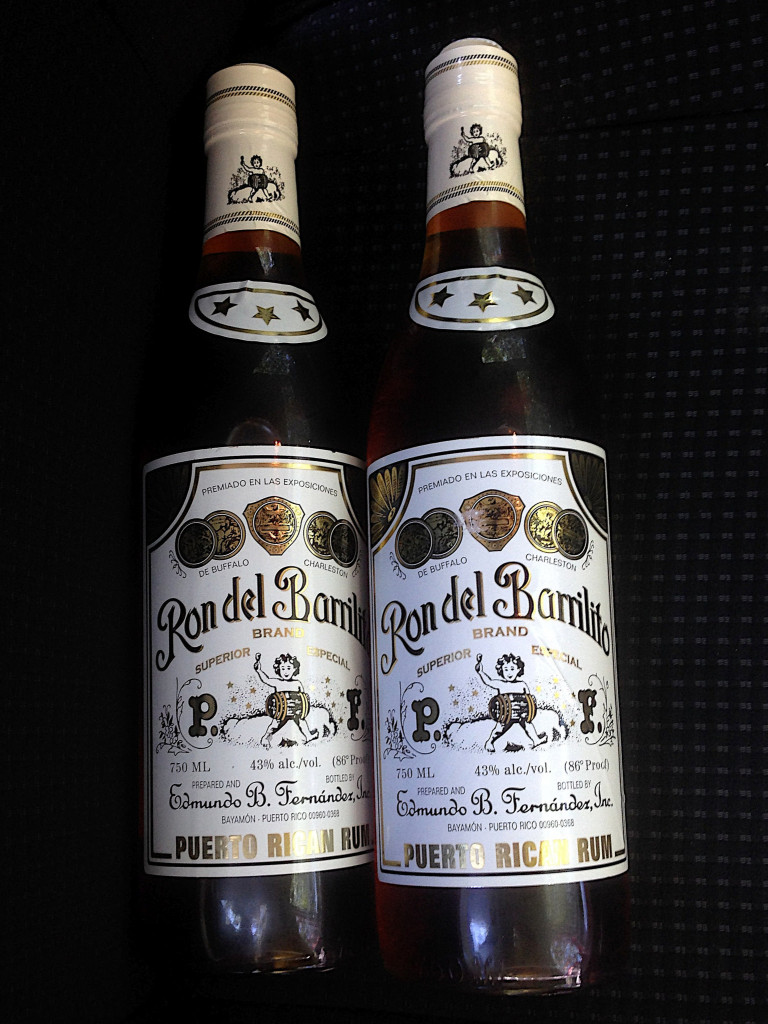Sugar production was integral to Puerto Rico’s modern history. It was the bounty of sugarcane that first brought an influx of Europeans to the island in the 1800s. Eventually the island was dotted with sugarcane plantations, sugar refineries, rum distilleries, and shipping operations. Around the turn-of-the-19th century, the sugar industry declined, but that didn’t stop the rum-making operations. Today, most of the world’s supply of rum is produced in Puerto Rico.
Bacardi is the top-selling brand, but it’s not the only game in town. Serralles Distillery in Ponce produces the well-regarded brand Don Q. Most locals recommend Ron del Barrilito, made in Bayamón, as the island’s most prized brand. In recent years, several small-batch craft rums have come to market, including Rum Caray made in Juncos and Trigo from Bayamón.
Here are some ways to explore the flavors and history of the island’s favorite elixir.

Puerto Rican rum. Photo © Alan Levine, licensed Creative Commons distribution.
Castillo Serrallés is proof of how lucrative rum production was for its makers.Casa Bacardi Visitor Center is a popular tourist attraction in Cataño devoted to the history of the top-selling rum in the United States, which is still owned and operated by descendants of founder Don Facundo Bacardi Masó. But don’t be misled into thinking you will take a tour of Bacardi’s rum distillery operations. No rum is made on-site. Instead, expect to see a film about the company’s origins in Cuba, historic objects used to make rum in its early days, and displays of advertisements through the years. The tour ends with two free rum cocktails.Castillo Serrallés is proof of how lucrative rum production was for its makers. Built atop a mountain overlooking Ponce in 1934 for Eugenio Serrallés, founder of Serrallés Rum Distillery, this stunning four-story Spanish Moroccan-style mansion contains many of the Serrallés family’s original furnishings. One room in the house has been converted into an exhibition space that explains and illustrates how sugar cane is processed and turned into rum.
Casa Melaza is a petite shop in Old San Juan that bills itself as a “rum boutique.” Owner Antonio Lizardi is a wealth of information about local rums. In addition to all the major brands, he carries an excellent selection of small-batch and aged rums ideal for sipping. You’ll also find locally produced sangrias and coffees.
The Piña Colada, a frozen concoction of rum, coconut cream, and pineapple juice, originated in San Juan. There’s no disputing that. But, the question remains: Who invented it? Ramon “Monchito” Marrero, a bartender at Caribe Hilton hotel, claimed to have made the first one in 1954 after three months of experimentation. Rumor has it that Joan Crawford said the drink was “better than slapping Bette Davis in the face.” But Spanish-born bartender Ramon Portas Mingot also claims to have made the first one at Barrachina restaurant in 1963. The difference between the two versions is Caribe Hilton makes it with ice and Barrachina makes it with water and freezes it before blending it. You can try one at both establishments and decide for yourself which one is best.
Chichaito is a clear, thimble-sized drink often served after a traditional Puerto Rican meal, as well as in most bars. (Its name is slang for “little fornicator.”) It is made from equal parts rum and anise-flavored liqueur and is downed in a single gulp that packs a powerful punch. La Casita Blanca in Santurce sends out a complimentary round after dinner, and Tres Cuernos in Old San Juan serves 31 flavored versions.
Taste of Rum (held in March) offers the opportunity to sample an array of Puerto Rican rums at this annual festival held at Paseo La Princesa in Old San Juan. The one-day event also features educational seminars, competitions, live music, dancing, and food vendors.
Excerpted from the Fourth Edition of Moon Puerto Rico.